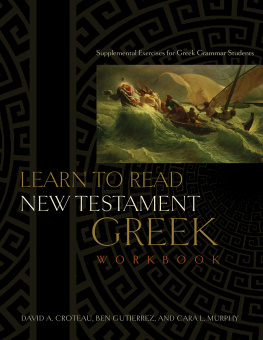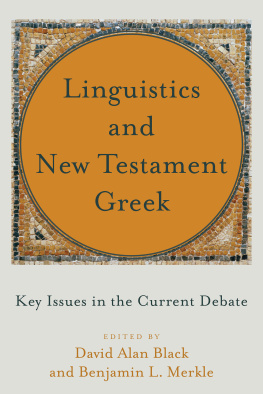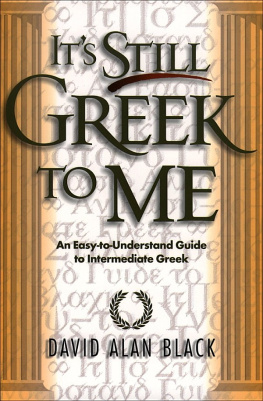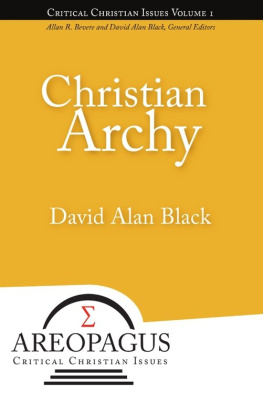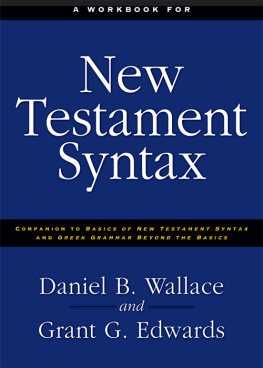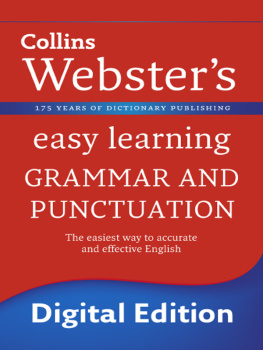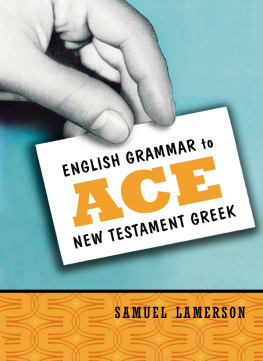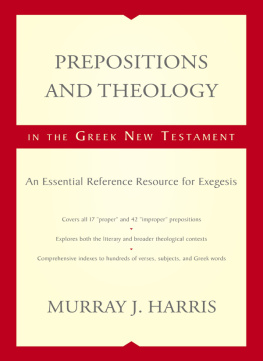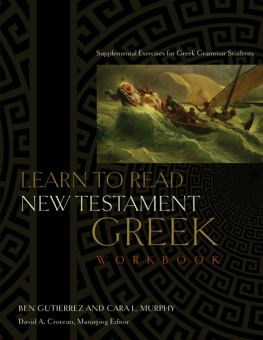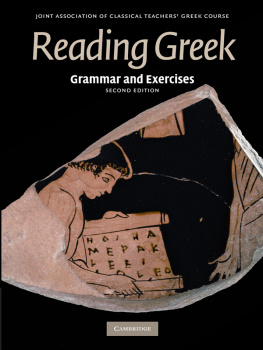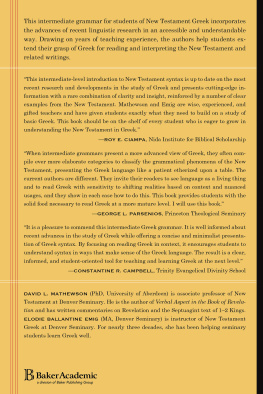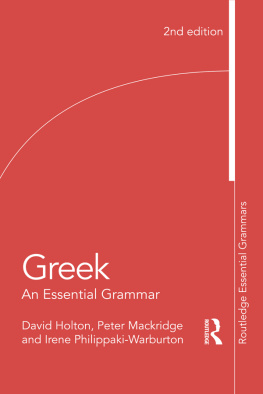Learn to Read New Testament Greek
Copyright 2009 by David Alan Black
All rights reserved.
Published by B&H Publishing Group
Nashville, Tennessee
ISBN: 978-0-8054-4493-3
Dewey Decimal Classification: 225.48
Subject Heading: GREEK LANGUAGE, BIBLICAL\BIBLE.N.T.GREEK
Greek Scripture quotations are from The Greek New Testament 1966, 1968, 1975 by the American Bible Society, British and Foreign Bible Society, National Bible Society of Scotland, Netherlands Bible Society, Wrttemberg Bible Society. Used by permission.
Printed in the United States of America
6 7 8 9 10 11 12 15 14 13 12 11
SB
To my Greek students
past,
present,
and future
About This Book
The Greek language has always had a peculiar attraction for both readers and expositors of the New Testament. More than a hundred introductory grammars of New Testament Greek have been produced in English alone, many of them by scholars of the first rank. It would be unusual, therefore, if the present grammar did not contain a great deal that has appeared elsewhere, and I am sure that the call for this book did not arise from the deficiencies of its predecessors. I find, nevertheless, some satisfaction in the knowledge that any subject is promoted, in however small a degree, by the independent treatment of the same material in the light of the most recent research. Accordingly, the aim of the present volume, which was written at the kind invitation of the publishers, has been to meet the need for up-to-date subject matter, a linguistically informed methodology, and an emphasis on contemporary models of language learning. The simplified explanations, basic vocabularies, and abundant exercises are designed to prepare the student for subsequent "practical" courses in exegesis, while the linguistic emphasis lays the groundwork for later courses in grammar. It is my hope that this book will prove to be not altogether unworthy of its predecessors, and that the nature of the lessons will establish it as a useful introduction to Greek linguistics, a field that is uniquely suited to provide new light on the words of Scripture.
The text is divided into 26 lessons, most of which are arranged according to the following pattern: a presentation of the grammatical concepts and forms to be learned, divided into manageable units; a list of essential vocabulary words to be mastered; and exercises based on the material covered in the lesson. The book is suitable for study or review, for individual or group work, as part of a refresher course, or as a handy reference guide. In most classroom settings it can be used for a full year of study by taking up a lesson a week, with ample time for supplementary testing and review.
Several characteristics of the lessons as a whole deserve a few words of explanation:
(1) In presenting the grammar proper, every attempt has been made not just to state rules but to give the student an understanding of the nature of the language, especially in such fundamental topics as the significance of verbal aspect and the function of the article.
(2) Since many students are unfamiliar with grammar and particularly with grammatical nomenclature, each topic is introduced by a simple preliminary explanation of terminology with illustrations from the English language.
(3) Throughout the text I have adopted the simplest language possible to explain the subject matter, and have included only those linguistic concepts and terms that in my judgment have the clearest application to the teaching of beginning Greek.
(4) Since the most inspiring approach to ancient Greek is through original Greek sentences, the lessons contain numerous examples derived from the New Testament itself and, as far as possible, containing only grammatical forms already introduced.
(5) Rote memorization of paradigms has been kept to an absolute minimum, and the student is instead taught how to recognize basic patterns in words and how to interpret these through morphological analysis.
(6) As an aid to understanding, various visual devices have been adopted, including the use of bold type, underlining, tables, and graphs.
(7) Finally, in presenting the chief features of the language, primary principles have been set forth in large type, while matters of detail have been presented in reduced type (without implying that the topics so presented are of minor importance or can be skipped).
The various inflected and uninflected forms presented here are normal for a beginning grammar. In view of the fact that many students have had no prior exposure to verb inflection, special care has been given to the gradual description of the Greek tenses. The tenses of the active indicative are presented as follows: present and future (Lesson 3), imperfect and aorist (Lesson 7), and perfect and pluperfect (Lesson 10). Subsequent lessons treat the middle and passive voices of the indicative mood, contract and liquid verbs, participles, infinitives, the subjunctive mood, the imperative and optative moods, and finally verbs of the - conjugation. Considerable effort has been made to place paradigms of more or less similar forms side by side for ease of comprehension (as with the present and future active indicative), as well as to have new forms follow related ones in natural sequence (as with contract and liquid verbs). On the other hand, the introduction of the middle and passive voices has been deliberately postponed until after the entire active system has been learned, a sequence that in actual practice has achieved the goal of a clearer understanding of the significance of verbal aspect in New Testament Greek. In order that the learner may have some opportunity to become acquainted with the Greek tenses before facing the challenge of inflection, a preliminary overview of the Greek verb system is given in Lesson 2. This is supplemented by a comprehensive review of the indicative mood in Lesson 16.
The vocabularies contain words that are of great enough frequency in the Greek New Testament to justify recommending that these words be learned permanently as soon as encountered. All the words of one type have been grouped together, and an unusually full list of English cognates and derivatives has been provided in order to demonstrate the close relationship between English and Greek and to enable the student to learn the vocabulary as easily and comprehensively as possible. Wherever possible, Greek roots have been added to the word lists. This is a device for easing the burden of vocabulary acquisition, and the instructor who uses this book as a text may wish to require these forms to be learned as part of the regular vocabulary, especially by students who plan to continue their studies of Greek beyond the first year.
The Greek-to-English exercises in the text are designed to illustrate the new grammatical principles introduced in the lesson as well as those forms and grammatical usages that have been discussed previously. By going over these exercises again and again, the student will gain considerable facility in the workings of the language. For the first part of the book, these sentences have only rarely been taken from the New Testament, though I have tried not to introduce any usages that are unnatural to the New Testament idiom. Beginning with Lesson 18, however, excerpts from the Greek New Testament are used exclusively for the translation exercises. This use of genuine Greek has a twofold aim: to give students an insight into the language and thought of the New Testament writers, and to prepare them for the crowning experience of their studiesreading and understanding the original text of the New Testament. A prime consideration in the inclusion of these excerpts was that the material be interesting per se and not chosen merely because it illustrates forms and syntax.
Because the emphasis throughout this text is on reading Greek rather than on Greek composition, the treatment of Greek accents has been assigned to an appendix. Other omissions include English-to-Greek exercises, numerals, and such rare forms and constructions as the future participle and infinitive, most of the optative, and used as a conjunction. Thus the reader will find here little that is simply "interesting"; the subjects presented are directly relevant to the interpretation of the Greek New Testament. Hence it is all the more critical that the student learn well whatever principles are included so as to be able to move as quickly as possible from grammar to exegesis.
Next page
